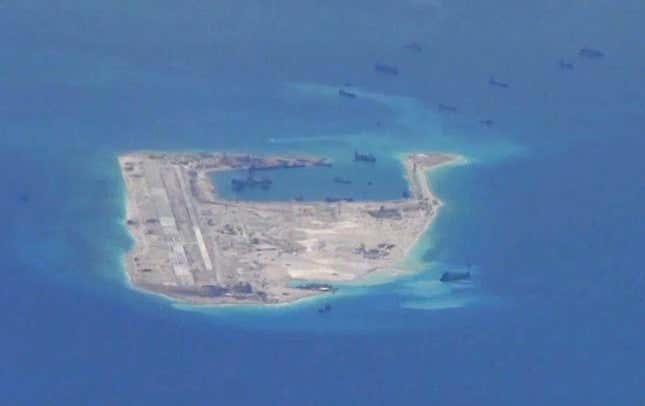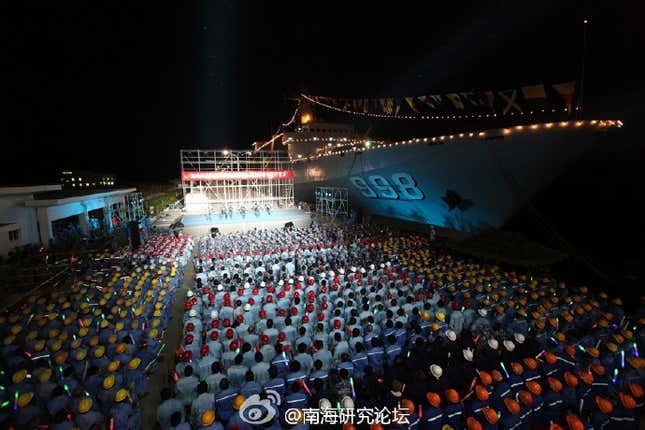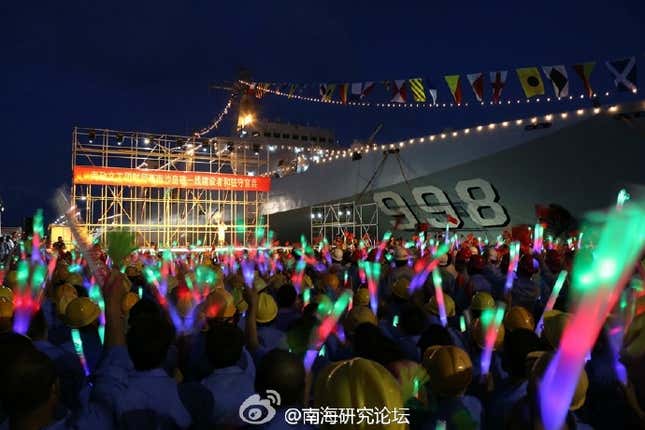Tensions in the South China Sea have sparked grave international concerns. A geopolitical misstep or two, some fear, could lead to war. But they’ve also produced developments that fall more into the category of the surreal and absurd.
Case in point: A Chinese musical troupe performing song and dance routines on an island that only recently came into existence. China started turning Fiery Cross Reef in the Spratly archipelago into an island in 2014, destroying unknown amounts of coral reef and marine life in the process. Here’s what Yongshu reef, as the Chinese call it, looked like a year ago:

Now the reef is a full-fledged island hosting a harbor large enough for warships, a runway suitable for fighter jets, and hundreds of military troops and support personnel—and, for one night at least, a stage. The Spratly islands, known in China as the Nansha islands, are truly in the middle of nowhere, and there isn’t much by way of entertainment.

Chinese singer Song Zuying, who’s shared the stage with the likes of Celine Dion and Placido Domingo, last weekend kicked off a nine-day tour of the South China Sea with a two-and-a-half-hour performance at Fiery Cross Reef. It included not only “My Heart Will Go On”—made famous by Dion, and the theme song to the blockbuster 1997 film Titanic—but also a stirring rendition of “Ode to the South Sea Defenders.”

Right alongside the performers was the Kunlunshan, a 20,000-ton warship and the second-largest vessel in the Chinese fleet. The maritime signaling flags added to the festive mood, as did the dutifully waved glow sticks and, in an odd way, the helmets worn by construction workers for no apparent reason.

Chinese state news coverage of the performance gave rare, brief glimpses of how far development at Fiery Cross Reef has come, such as the 0:22 mark in this CCTV report:
The report says the tour includes more than 10 islands in the contested Spratly and Paracel archipelagos. Amid the patriotic songs are performances depicting the families of the workers and military personnel waiting for them to return home.
China claims nearly all of the South China Sea as its own. That claim will likely be rejected when an international tribunal rules on the matter in the coming weeks. The Philippines, which like other Southeast Asian nations has competing claims in the sea, brought the legal challenge a few years ago.
This week the Philippines provided some surreal theatrics of its own. Pugnacious Davao City mayor and presidential front-runner Rodrigo Duterte said that if China refuses to recognize the ruling of the international tribunal, which is also likely, he will personally ride a jet-ski to one of the contested Spratly islands while carrying a Filipino flag, which he will plant himself.
Additional reporting by Zheping Huang
